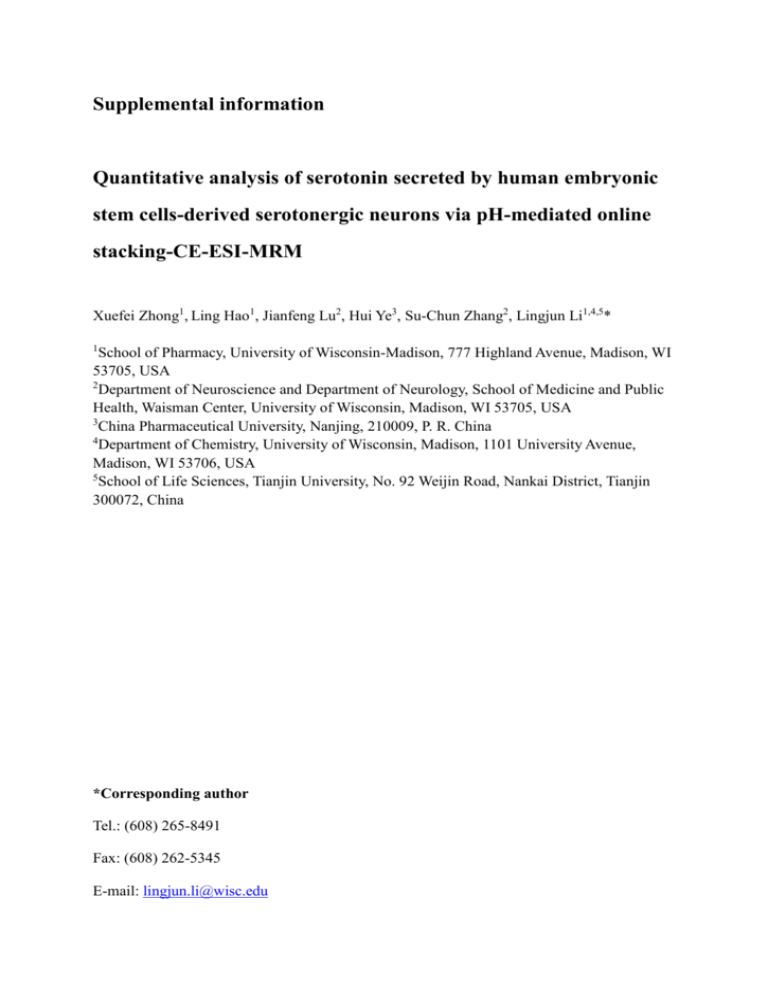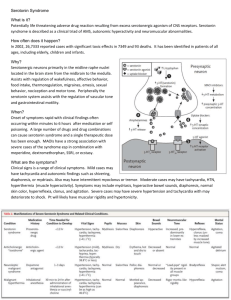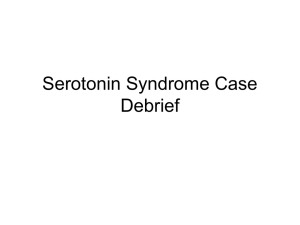elps5760-sup-0001-supinfo
advertisement

Supplemental information Quantitative analysis of serotonin secreted by human embryonic stem cells-derived serotonergic neurons via pH-mediated online stacking-CE-ESI-MRM Xuefei Zhong1, Ling Hao1, Jianfeng Lu2, Hui Ye3, Su-Chun Zhang2, Lingjun Li1,4,5* 1 School of Pharmacy, University of Wisconsin-Madison, 777 Highland Avenue, Madison, WI 53705, USA 2 Department of Neuroscience and Department of Neurology, School of Medicine and Public Health, Waisman Center, University of Wisconsin, Madison, WI 53705, USA 3 China Pharmaceutical University, Nanjing, 210009, P. R. China 4 Department of Chemistry, University of Wisconsin, Madison, 1101 University Avenue, Madison, WI 53706, USA 5 School of Life Sciences, Tianjin University, No. 92 Weijin Road, Nankai District, Tianjin 300072, China *Corresponding author Tel.: (608) 265-8491 Fax: (608) 262-5345 E-mail: lingjun.li@wisc.edu Serotonin (5-HT) calibration standards were prepared by spiking 0, 20, 40, 80, 120 μL of stock solution (0.2 μg/mL in water) into 1.6 mL of blank K-R solution respectively. The calibration standard solution or collected washing solution was then spiked with 22 ng of d4serotonin (internal standard) and 320 µL of ammonium hydroxide. Liquid-liquid extraction was performed by adding 500 µL of ethyl acetate into the cell media, vortexing the mixture for 30 sec, followed by 10 min ultrasonic bath. After centrifugation (14,000×g, 5 min), approximately 450 µL of upper organic phase was collected. This liquid-liquid extraction procedure was repeated three times and the combined organic phase was evaporated by a SpeedVac concentrator. The extracted samples were reconstituted in 20 µL of 50% methanol and 1% ammonium hydroxide prior to CE-ESI-MS/MS analysis. The CE separation was carried out by an Agilent HP G1600AX 3D-CE system and the MS data was recorded by an Agilent 1100 MSD Trap mass spectrometer (Agilent Technologies, Inc. Santa Clara, CA). The interfacing between CE and MS was originally developed by Maxwell et al [1, 2] and adapted to fit the ESI source of the Agilent 1100 MSD Trap mass spectrometer as depicted in Figure S1. 30 kV was applied across a 65 cm long, 50 µm inner diameter bare fused silica capillary (Polymicro Technologies, Phoenix AZ) for separation. 50% methanol and 0.2 % formic acid was used as background electrolyte. The modifier solution containing 50% methanol and 0.2% formic acid was infused at 0.3 µL/min during separation. The s.s. ESI emitter was grounded and the distance between emitter tip and the spray shield was around 1.5 cm. The MS source parameters were set as follows: ESI voltage (spray shield) - 4.2 kV, nebulizer gas disabled, dry gas, 300 degrees, 1.0 L/min. Positive ESI and MRM mode were used for MS data acquisition. Transition channels m/z 177 m/z 160 and m/z 181 m/z 164 were used for monitoring signal responses from serotonin and d4-serotonin respectively. The precursor ion isolation window was set as 3 Th, and collision energy applied for both precursor ions was 0.76 V. The ion accumulation time of the ion trap was set as 10 mS, average number was set as 3. Ratios of the peak areas of serotonin and d4-5HT were calibrated against standard curves for accurate quantification. The peak area ratios of extracted ion electropherograms (EIEs) of the transition channels m/z 177 m/z 160 and m/z 181 m/z 164 were used for construction of the calibration curve. Three CE-MS technical replicates were performed for each calibration standard solution (0, 2.5, 5, 10, 15 ng/mL serotonin spiked in K-R solution) and the samples. The calibration curve is shown in Figure S2. Intra-day coefficient of variance (CV) of the 2.5 ng/mL serotonin standard solution was 4.0% (n=3), and intra-day CV of the 10 ng/mL serotonin standard solution was 4.9% (n=3). The linearity of the calibration curve (r2) was 0.9996. Representative EIEs of the serotonin and the internal standard are shown in Figure S3, including calibration blank (Figure S3A), 10 ng/mL serotonin calibration standard (Figure S3B), serotonin released by hESCs-derived serotonergic neurons in depolarizing K-R solution (Figure S3C) and K-R solution (Figure S3D), cell releasate of the dorsal hindbrain derived-neurons in depolarizing K-R solution (Figure S3E) and K-R solution (Figure S3F) which served as biological control samples. In both calibration blank (Figure S3A) and biological control samples (Figure S3E-F), serotonin was not detectable (S/N < 3). The temperature fluctuation and evaporation of volatile components in the separation buffers during the CE runs might cause minor shift in the measured CE migration time. Figure S1. Photo of instruments used for the CE-ESI-MRM experiments. CE separation was carried out using an Agilent HP 3D CE system. The subsequent MS detection was performed on an Agilent 1100 LC/MSD Trap instrument. The inset is an enlarged view of the CE-ESI-MS interface. The stainless steel (s.s.) ESI emitter was grounded and - 4.2 kV was applied on the spray shield. The distance between the sprayer emitter tip and the MS inlet was around 1.5 cm. Figure S2. Calibration curve of serotonin meausrement by CE-ESI-MRM. Figure S3. Extracted ion electropherograms of serotonin (red, m/z 177 −>160) and internal standard d4-serotonin (blue, m/z 181 −>164). (A) calibration blank; (B) 10 ng/mL serotonin calibration standard; cell releasate from (C) hESCs-derived serotonergic neurons in depolarizing K-R solution and (D) hESCs-derived serotonergic neurons in K-R solution; cell releasate from (E) dorsal hindbrain derived-neurons in depolarizing K-R solution and (F) dorsal hindbrain derived-neurons in K-R solution. 22 ng/mL internal standard d4- serotonin were spiked in 1.6 mL K-R solution. CE conditions were the same as used for Figure 2E. [1] Maxwell, E. J., Zhong, X. F., Zhang, H., van Zeijl, N., Chen, D. D. Y., Electrophoresis 2010, 31, 1130-1137. [2] Zhong, X. F., Maxwell, E. J., Chen, D. D. Y., Anal. Chem. 2011, 83, 4916-4923.





